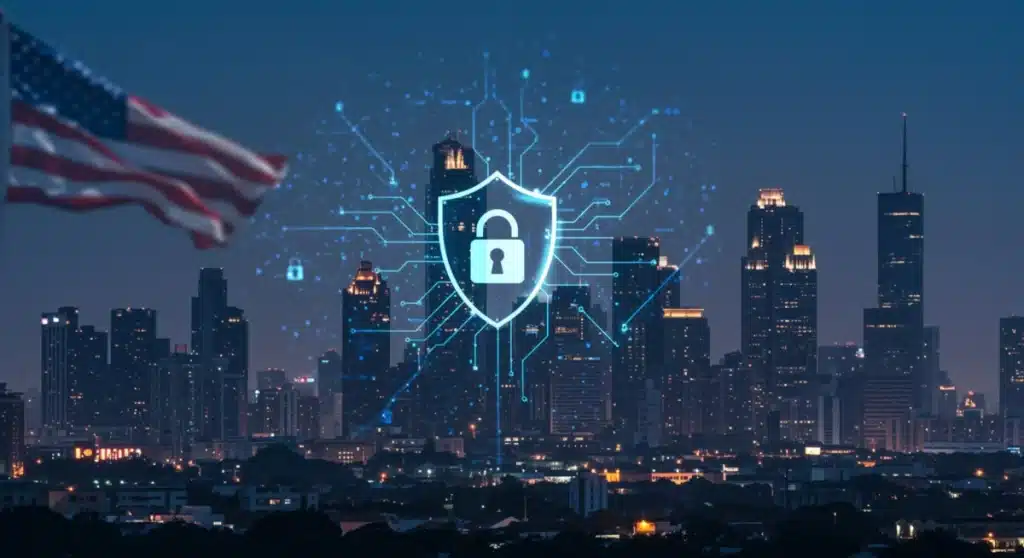Cybersecurity Innovation: Protecting US Businesses in 2025

Cybersecurity innovation is paramount for US businesses to defend against evolving digital threats in 2025, requiring advanced strategies like AI-driven defense, zero trust architectures, and comprehensive employee training to ensure resilience.
As the digital landscape continuously shifts, the imperative for robust cybersecurity innovation US businesses face in 2025 has never been more critical. Organizations across various sectors are grappling with increasingly sophisticated and persistent cyber threats, demanding a proactive and adaptive approach to protection. This discussion explores the pivotal innovations and strategic frameworks essential for safeguarding American enterprises in the coming year, ensuring their resilience against the ever-evolving adversarial tactics.
The Evolving Threat Landscape for US Businesses
The digital battleground is constantly expanding, presenting unprecedented challenges for US businesses. Cybercriminals, nation-state actors, and insiders are leveraging advanced techniques to exploit vulnerabilities, making traditional perimeter defenses increasingly inadequate. Understanding the nature of these evolving threats is the first step towards developing effective countermeasures.
In 2025, we anticipate a surge in highly targeted attacks, moving beyond broad phishing campaigns to more personalized and deceptive social engineering tactics. These attacks often exploit human vulnerabilities, making them particularly difficult to detect through automated systems alone. The sheer volume and complexity of data breaches are also expected to rise, impacting not just large corporations but also small and medium-sized businesses (SMBs), which often lack the resources for sophisticated cybersecurity infrastructure.
Sophistication of Cyber Attacks
Cyber adversaries are no longer relying on basic malware. Their toolkits now include highly polymorphic viruses, fileless malware, and advanced persistent threats (APTs) that can remain undetected within networks for extended periods. These sophisticated attacks require equally sophisticated defensive mechanisms.
- Ransomware as a Service (RaaS): The proliferation of RaaS models lowers the barrier to entry for cybercriminals, leading to more frequent and devastating ransomware attacks.
- Supply Chain Attacks: Compromising a single vendor can provide access to numerous client networks, making supply chain integrity a critical vulnerability.
- AI-Powered Attacks: Adversaries are beginning to use AI and machine learning to automate attack reconnaissance, develop more convincing phishing content, and evade detection.
The convergence of these factors paints a challenging picture, underscoring the urgent need for US businesses to invest in cutting-edge cybersecurity innovation. Adapting to this dynamic environment requires not just reacting to threats but proactively anticipating and neutralizing them before they can inflict significant damage.
Artificial Intelligence and Machine Learning in Defense
The integration of Artificial Intelligence (AI) and Machine Learning (ML) is revolutionizing cybersecurity, offering unprecedented capabilities for threat detection, analysis, and response. These technologies are no longer theoretical concepts but essential tools in the arsenal of any forward-thinking US business aiming to protect its digital assets in 2025.
AI and ML algorithms can process vast amounts of data at speeds impossible for human analysts, identifying patterns and anomalies that indicate potential threats. This allows for real-time threat intelligence and automated responses, significantly reducing the window of opportunity for attackers. From predicting future attack vectors to automating incident response, AI is transforming every facet of cybersecurity.
Predictive Threat Intelligence
One of the most significant advantages of AI in cybersecurity is its ability to provide predictive threat intelligence. By analyzing historical data, global threat feeds, and behavioral patterns, AI can anticipate where and how the next attack might occur.
- Behavioral Analytics: AI systems can baseline normal user and system behavior, flagging any deviations that might signal a compromise.
- Vulnerability Prioritization: ML algorithms can identify and prioritize vulnerabilities that are most likely to be exploited, allowing businesses to focus their patching efforts effectively.
- Automated Forensics: AI can rapidly analyze breach data to understand the scope and origin of an attack, accelerating recovery.
While AI offers immense potential, its implementation requires careful planning and skilled personnel. Businesses must ensure their AI systems are continuously trained with up-to-date threat data to remain effective against new attack methodologies. The symbiotic relationship between human expertise and AI capabilities will define the next generation of cybersecurity defense.

Implementing Zero Trust Architectures
In an era where traditional perimeter-based security models are proving insufficient, the Zero Trust architecture has emerged as a cornerstone of modern cybersecurity. For US businesses looking ahead to 2025, adopting a Zero Trust model is not just an option but a strategic imperative to enhance their defensive posture.
Zero Trust operates on the principle of “never trust, always verify.” It assumes that every user, device, and application attempting to access resources, whether inside or outside the network perimeter, is a potential threat until proven otherwise. This paradigm shift mandates strict identity verification and continuous authorization for all access requests, significantly reducing the risk of unauthorized access and lateral movement by attackers.
Key Pillars of Zero Trust
Implementing a Zero Trust architecture involves several foundational components that collectively enforce a stringent security policy. These pillars work in concert to create a robust and adaptable security environment.
- Identity Verification: Strong multi-factor authentication (MFA) and continuous identity verification for all users and devices.
- Micro-segmentation: Dividing networks into smaller, isolated segments to limit lateral movement of threats.
- Least Privilege Access: Granting users and applications only the minimum necessary access to perform their tasks.
- Continuous Monitoring: Real-time monitoring of all network traffic and user behavior for suspicious activities.
The transition to Zero Trust can be complex, requiring a comprehensive understanding of an organization’s assets, users, and data flows. However, the long-term benefits in terms of enhanced security, reduced attack surface, and improved compliance make it a worthwhile investment for any US business committed to protecting its future.
The Role of Quantum Computing and Post-Quantum Cryptography
While still in its nascent stages, quantum computing poses both a profound threat and a potential solution to current encryption standards. For US businesses, understanding the implications of quantum computing and preparing for post-quantum cryptography (PQC) is a critical long-term cybersecurity innovation challenge for 2025 and beyond.
Quantum computers, once fully realized, will have the capability to break many of the cryptographic algorithms that currently secure our digital communications and data. This impending threat necessitates the development and adoption of new cryptographic methods that are resistant to quantum attacks. Businesses that handle sensitive data must begin to assess their cryptographic dependencies and plan for migration to PQC standards.
Preparing for a Quantum Future
The transition to post-quantum cryptography will be a significant undertaking, requiring collaboration between industry, academia, and government. Proactive planning is essential to avoid a future “cryptographic apocalypse” where current encryption schemes become obsolete overnight.
- Inventory Cryptographic Assets: Identify all systems, applications, and data that rely on cryptographic protection.
- Assess Quantum Risk: Determine the potential impact of quantum computing on existing security infrastructure.
- Pilot PQC Solutions: Begin testing and evaluating post-quantum cryptographic algorithms in non-production environments.
The journey towards quantum-resistant security is long and complex, but early engagement and strategic planning will position US businesses favorably. Integrating PQC considerations into current cybersecurity innovation strategies will ensure long-term data integrity and confidentiality in the face of emerging quantum threats.
Strengthening Human Element: Training and Awareness
Even the most advanced technological defenses can be undermined by human error. In 2025, strengthening the human element through comprehensive training and continuous awareness programs remains a critical, yet often underestimated, aspect of cybersecurity innovation for US businesses. Employees are often the first line of defense, and their vigilance is crucial.
Social engineering attacks, such as sophisticated phishing and pretexting, continue to be highly effective because they exploit human psychology rather than technical vulnerabilities. Therefore, investing in robust cybersecurity education for all employees, from entry-level staff to senior executives, is paramount. A well-informed workforce can identify and report suspicious activities, acting as an additional layer of security.
Effective Cybersecurity Training Strategies
Beyond basic awareness, effective training programs should be engaging, relevant, and regularly updated to address the latest threat vectors. They should foster a culture of security where every employee understands their role in protecting the organization’s assets.
- Regular Phishing Simulations: Conduct simulated phishing campaigns to test employee vigilance and provide immediate feedback.
- Interactive Workshops: Offer hands-on workshops that explain common attack techniques and best practices for prevention.
- Role-Based Training: Tailor training content to specific job roles, addressing the unique cybersecurity risks associated with each.
- Continuous Awareness Campaigns: Utilize internal communications, posters, and newsletters to keep cybersecurity top of mind.
By empowering employees with the knowledge and tools to recognize and respond to cyber threats, US businesses can significantly reduce their attack surface and build a more resilient defense. A human firewall, combined with technological innovation, creates a truly formidable security posture.

Regulatory Compliance and Data Privacy
The landscape of regulatory compliance and data privacy is becoming increasingly complex, presenting both challenges and opportunities for US businesses. In 2025, adherence to evolving privacy laws and industry-specific regulations will not only be a legal requirement but also a critical component of a trustworthy cybersecurity posture and a key area for cybersecurity innovation.
New regulations, both at the state and federal levels, are continuously emerging to address concerns around data collection, usage, and protection. Non-compliance can result in severe financial penalties, reputational damage, and loss of customer trust. Therefore, businesses must integrate compliance considerations into their cybersecurity strategies from the outset, ensuring that their data handling practices meet the highest standards.
Navigating the Regulatory Maze
Understanding and implementing the requirements of various regulations can be daunting. Businesses need clear strategies to ensure they remain compliant while also maintaining operational efficiency.
- Data Mapping: Understand where sensitive data resides, how it flows through the organization, and who has access to it.
- Privacy by Design: Integrate privacy considerations into the design and development of all new systems and processes.
- Regular Audits: Conduct periodic internal and external audits to ensure ongoing compliance with relevant regulations.
- Incident Response Planning: Develop robust incident response plans that address notification requirements for data breaches under various laws.
Proactive engagement with regulatory compliance is not merely about avoiding penalties; it’s about building trust with customers and partners. Businesses that demonstrate a strong commitment to data privacy and security will gain a competitive advantage in the market, making regulatory adherence a vital aspect of cybersecurity innovation.
Collaborative Defense and Information Sharing
No single organization can effectively combat the entirety of modern cyber threats in isolation. For US businesses in 2025, collaborative defense and robust information sharing are becoming indispensable components of a comprehensive cybersecurity strategy. Sharing threat intelligence and best practices can significantly enhance the collective security posture.
Cyber adversaries often share tactics and exploit similar vulnerabilities across different sectors. By contrast, a fragmented defense leaves individual businesses vulnerable. Information sharing initiatives, whether through industry-specific groups, government agencies, or public-private partnerships, allow organizations to learn from each other’s experiences, anticipate new threats, and deploy defenses more rapidly and effectively.
Benefits of Cyber Threat Intelligence Sharing
Participating in threat intelligence sharing communities offers numerous advantages, enabling businesses to stay ahead of emerging threats and improve their overall resilience.
- Early Warning Systems: Receive timely alerts about new vulnerabilities, attack campaigns, and indicators of compromise (IoCs).
- Enhanced Situational Awareness: Gain a broader understanding of the threat landscape beyond their own organization.
- Improved Response Capabilities: Access to shared playbooks and best practices for incident response.
- Collective Defense: Contribute to a stronger, more resilient cybersecurity ecosystem for all participants.
Building trusted relationships and secure platforms for information exchange are crucial for the success of collaborative defense efforts. By embracing a spirit of cooperation, US businesses can collectively elevate their cybersecurity innovation capabilities and create a more secure digital environment for everyone.
| Key Area | Brief Description |
|---|---|
| AI & Machine Learning | Automating threat detection, analysis, and response for enhanced security posture. |
| Zero Trust Architecture | “Never trust, always verify” model reducing unauthorized access risk. |
| Human Element Training | Empowering employees as a critical defense layer against social engineering. |
| Collaborative Defense | Information sharing and partnerships to combat collective cyber threats. |
Frequently Asked Questions About Cybersecurity Innovation
For 2025, US businesses face heightened threats from AI-powered attacks, sophisticated ransomware as a service (RaaS), supply chain compromises, and advanced persistent threats (APTs). These attacks exploit both technical vulnerabilities and human factors, making them increasingly challenging to defend against without innovative solutions.
AI and ML significantly bolster defenses by enabling predictive threat intelligence, automating real-time anomaly detection, and accelerating incident response. They analyze vast datasets to identify subtle patterns indicative of attacks, prioritize vulnerabilities, and provide automated forensic analysis, thereby reducing human workload and improving reaction times.
Zero Trust is a security model based on “never trust, always verify,” assuming no user or device is inherently trustworthy, even inside the network. It’s crucial for US businesses because it minimizes the attack surface through continuous verification, micro-segmentation, and least privilege access, effectively preventing unauthorized access and lateral threat movement.
Employee training is paramount as the human element remains a primary target for cybercriminals. Well-trained employees can identify and report social engineering attempts like phishing, acting as a vital human firewall. Continuous education fosters a security-aware culture, significantly reducing the risk of breaches caused by human error.
Collaborative defense and information sharing are vital because cyber threats are collective challenges. By sharing threat intelligence, best practices, and incident data through industry groups and partnerships, US businesses can gain early warnings, enhance situational awareness, and collectively build a more resilient and responsive cybersecurity ecosystem against common adversaries.
Conclusion
The journey to secure US businesses against the evolving cyber threats of 2025 is a dynamic and continuous one, demanding a multifaceted approach centered on cybersecurity innovation. From harnessing the power of AI and Machine Learning for predictive defense to implementing robust Zero Trust architectures, the technological imperative is clear. However, technology alone is insufficient. Strengthening the human element through rigorous training and fostering a culture of security among employees remains equally critical. Furthermore, proactive engagement with regulatory compliance and embracing collaborative defense strategies through information sharing are indispensable components of a holistic security posture. By strategically integrating these innovations and approaches, US businesses can not only mitigate risks but also build resilient and trustworthy digital foundations, ensuring their continued growth and prosperity in an increasingly interconnected world.





